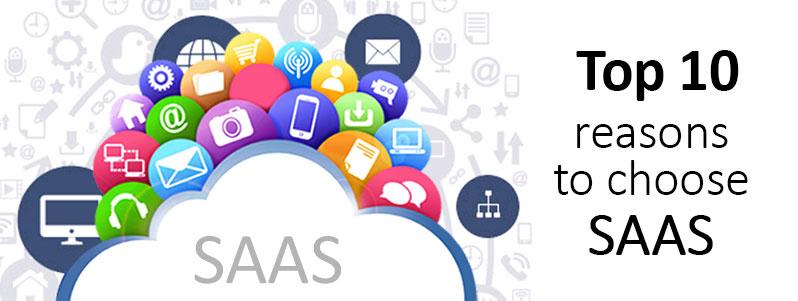What is Software as a Service (SaaS)?
Software as a Service (SaaS) is a software licensing and delivery model in which software is licensed on a subscription basis and is centrally hosted by a vendor or service provider and made available to customers over a network, typically the Internet. SaaS is typically accessed by users via a web browser. In SaaS, the user does not pay for the software itself. Instead, it works like a rental. They have the authorization to use it for a period of time and pay for the software that they are using.
Software as a service (SaaS) is an alternative to the standard software installation in the business environment (traditional model) where a user has to build the server, install the application and configure it. So, why should a business, especially a start-up or a SME, spend their precious time and money on building and maintaining infrastructure when they can host in the cloud?
SaaS has become a popular common delivery model for many business applications and has been incorporated into the strategy of all many companies.
Advantage SMEs
A SaaS based model offers many advantages for the SMEs and the budding entrepreneurs who want to create their online stores/portals for selling products and services. Hosted SaaS based ecommerce solutions allow small online retailers to open functional e-stores with a minimal of capital expense. StoreHippo is SaaS based platform using latest and blazing fast technology stack to build seamless online stores with a cost effective strategy. Hippo gives you a peep into the advantages of SaaS based eCommerce solutions.
1. Cost Saving
As compared to the traditional model, SaaS has a winning edge with respect to costs since it usually resides in a shared or multi-tenant environment where the hardware and software license costs are lower. Traditionally, the companies were required to buy, build, and maintain their IT infrastructure despite exponential costs. By using SaaS, the small companies can reduce IT support costs by outsourcing software maintenance and support to the SaaS provider. Having the SaaS provider manage the IT infrastructure means lower IT costs for hardware and software. In just a few hours, a hosting provider can provide dedicated servers and cloud servers, and your business will be up and running with limited cost and risk. SaaS gives companies a viable alternative. Now, they can subscribe to services built on shared infrastructure via the Internet. A reliable internet connection is all that a company needs.
2. Wider Customer Base
Another advantage is that the customer base can be increased since SaaS allows Small andMedium Businesses (SMBs) to use a software that otherwise they would not use due to the high cost of license. SaaS applications are subscription based. No license fees mean lower initial costs. Maintenance& costs are reduced as well, since the SaaS provider owns the environment and it is split among all customers that use that solution.
3. Scalability and Integration
Usually, SaaS solutions reside in cloud environments that are scalable and have integration with other SaaS offerings. Compared with the traditional model, users do not have to buy another server or software. They only need to enable a new SaaS offering and the SaaS provider will take care of most of the technical requirements.
4. Easy Upgrades and Time Saving
SaaS providers upgrade the solution and manage all updates and upgrades. So, it becomes available for their customers quickly. Costs and effort associated with upgrades and new releases are lower than the traditional model that usually forces the user to buy an upgrade package and install it, or get the environment upgraded through a specialized service. The SaaS provider also manages availability, so there’s no need for customers to add hardware, software, or bandwidth as the user base grows.
In contrast to the traditional model, in SaaS, the software (application) is already installed and configured. This reduces the time spent in installation and configuration, and can reduce the issues that can get in the way of the software deployment.
5. Better Security
In SaaS access to data is restricted using passwords, certificates and insulated workspaces. SaaS provides better security than on-premise software used by companies.
6. Easy to use and perform proof of concepts
SaaS offerings are easy to use since they already come with best practices and samples. Users can do proof of concepts and test the software functionality or a new release feature in advance.
7. High Adoption
SaaS applications are available from any computer or any device-anytime, anywhere. Because most people are familiar with using the Internet to find what they need, SaaS tend to have high adoption rates.
8. Seamless Integration
SaaS vendors with true multi-tenant architectures can scale indefinitely to meet customer demandsMany SaaS providers also offer customization capabilities to meet specific needs. Plus, many provide APIs that let you integrate with existing ERP systems or other business productivity systems.
9. Reduced need of IT Staff
Since the SaaS provider handles all the issues related to support, upgrades, scalability, maintenance compatibility, security/ malware updates, the companies do not need to hire much of technical staff.
10. Greener Footprint
Last but not the least SaaS is a greener IT solution. Many customers pool their server and data storage requirements. Less energy is consumed by the system and less of hardware is required. This, in turn, reduces the industrial waste of computer equipment, which is a major issue of concern in many countries.
https://www.storehippo.com/
9th Floor, Spaze iTech Park, A1-Tower, Sector-49 Sohna Road, Gurgaon, Haryana 122018, CIN - U72200HR2015PTC054459 122001 Gurgaon IN
StoreHippo https://www.storehippo.com/
9th Floor, Spaze iTech Park, A1-Tower, Sector-49 Sohna Road, Gurgaon, Haryana 122018, CIN - U72200HR2015PTC054459 Gurgaon, IN
+918010117117 https://www.storehippo.com/s/5667e7d63086b2e718049ad9/ms.settings/521c4d7548c284890e000001/594a155440e9fb9e592f2ba9-480x480.png" [email protected]Information
Features
© copyright 2020 StoreHippo.com . All Rights Reserved.






















Leave a Reply